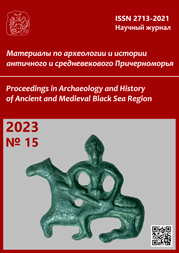Танаисские сюжеты Сергея Всеволодовича Кулланды (памяти друга)
Tanais stories by Sergey Vsevolodovich Kullanda (in memory of a friend)
Author(s): Yu.K. GuguevSubject(s): History, Language and Literature Studies
Published by: Нижневартовский государственный университет
Keywords: the Lower Don area; the Caucasus; Tanais; Roman Period; lapidary inscriptions; Iranian onomastics; phonetics; dialects; the Sarmatian language; the Middle Sarmatian Сulture; the Late Sarmatian Сultur
Summary/Abstract: Letters and notes, dating back to 2002—2003, of the late Moscow historian, a specialist in comparative historical linguistics S.V. Kullanda are published. They contain preliminary results of his study on the Roman period Iranian onomastics in Tanais, mainly of the 2nd century CE. S.V. Kullanda’s main assumptions can be summarized as follows: (1) calculations of the percentages of Greek and Iranian names, with Sarmatian and non-Sarmatian ones among the latter, made by some scholars, are not entirely reliable because they are based on erroneous criteria, while there are phonetic criteria for separating Scythian names from Sarmatian ones, or “early” Sarmatian names from much “later” ones; (2) a large number of Sarmatian names only appears in the epigraphy of Tanais from the middle of the 2nd century CE, while the famous inscription of 155 CE provides us with a slightly higher share of Sarmatian names than it was previously thought; (3) Sarmatian names are found in the inscriptions of the first half of the 2nd century CE, and, therefore, onomastic data do not allow us to assert that the late Sarmatian destruction of the city, revealed by archaeologists, occurred before 155 CE; (4) at Tanais, traces of two dialects of the Sarmatian language are registered, one of which, the one spoken probably by the representatives of the Middle Sarmatian Culture, is phonetically close to the later Ossetian language. Commenting on the linguistic observations by S.V. Kullanda, the author of this paper concludes that they confirmed or, in any case, do not contradict the archaeological data (Тanais, the Sarmatian Cultures of the steppe, the Alan Culture of the Caucasus). It is hoped that both historians and specialists in Iranian linguistics will become interested in the problems posed by S.V. Kullanda on the material of the Iranian onomastics of Tanais, and will offer ways and options for their solution.
Journal: Материалы по археологии и истории античного и средневекового Причерноморья
- Issue Year: 2023
- Issue No: 15
- Page Range: 971-994
- Page Count: 24
- Language: Russian

